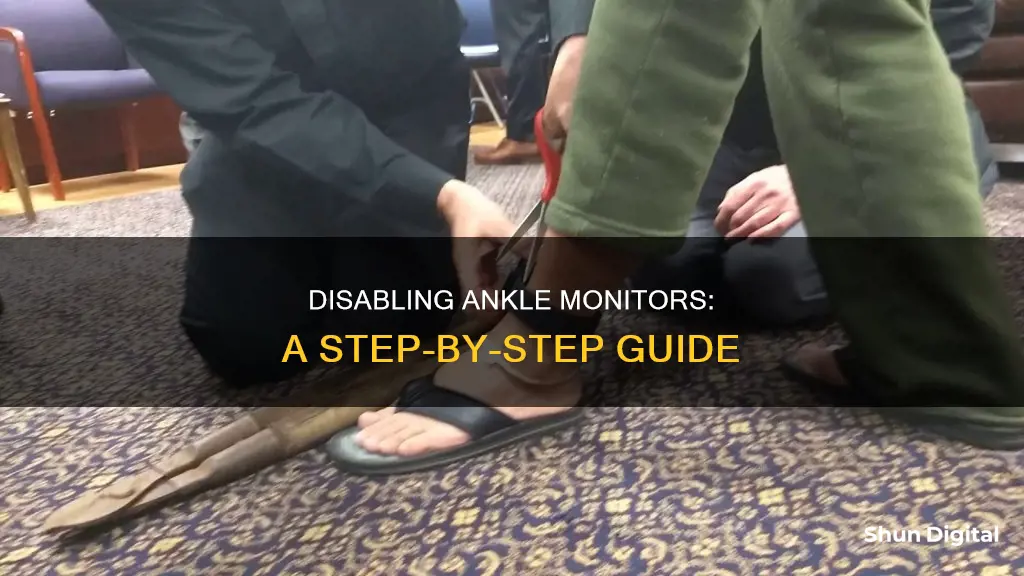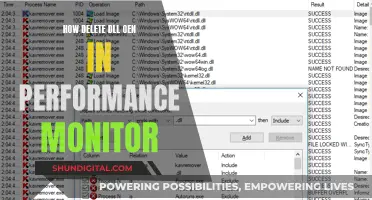
Ankle monitors are a common measure to ensure people abide by court-mandated restrictions. While the device can be a source of stress and distraction for the wearer, removing it illegally is not recommended. The proper way to have an ankle monitor removed is by submitting an official request to the court, where a judge will consider all aspects and make a decision. This involves drafting a motion document, which must adhere to specific rules and protocols, and may require the assistance of a legal attorney. The motion should include legitimate reasons for removal, such as job-related requirements, medical attention, or severe ankle pain. It is also crucial to maintain a positive relationship with the supervision officer, as their recommendation can influence the judge's decision.
What You'll Learn

Submit an official request to the court
To submit an official request to the court to remove your ankle monitor, you will need to follow a specific process. Here is a step-by-step guide to help you navigate the process effectively:
Step 1: Understand the Process
First, it is important to know that submitting a request to the court is called filing a motion. A motion is a formal request asking the court to modify an existing order or decision. In this case, your request to remove the ankle monitor would be the subject of the motion. It is your responsibility to file the motion, and consulting with a legal attorney who can guide you through the process is highly recommended.
Step 2: Have a Legitimate Reason
The court will expect you to provide a valid reason for wanting to remove your ankle monitor. Examples of good reasoning include job-related requirements or conflicts, the need for medical attention, severe ankle pain or injury, mental stress, or the need for specific medical procedures such as an MRI, CT-scan, or X-ray. Having a strong and legitimate reason will help convince the judge to consider your request.
Step 3: Communicate with Your Supervision Officer
If you have a supervision officer, it is in your best interest to have them on your side. Explain your reasons for wanting to remove the ankle monitor and seek their support. Their recommendation can carry weight in court and influence the judge's decision. Keep in mind that your compliance with any restrictions and maintaining a positive relationship with your supervision officer can improve your chances of a favourable outcome.
Step 4: Prepare the Motion Document
Creating the motion document requires attention to detail. Consult with your attorney to ensure it adheres to the specific rules, protocols, and requirements of the court. The motion should include the following elements:
- Caption Information: Include the name of the court, the plaintiff or prosecutor, and the defendant.
- Title and Body of the Motion: Title it appropriately, such as "Motion to Modify Probation/Parole/Bail." In the body, introduce yourself and clearly state your request to have the ankle monitor removed.
- Case Background: Provide details about your case, including the starting date, the reason for the ankle monitor, and the length of the condition set by the court.
- Reasons for Removal: Explain your main arguments for why the ankle monitor should be removed. Mention any good behaviour, compliance with court orders, or other relevant facts that support your request.
- Conclusion: Restate your request and include a date and your signature.
- Certificate of Service: Include a statement confirming that you have sent a copy of the motion to the relevant parties, such as your prosecutor and supervision officer.
- Proposed Order: Prepare a document called an "Order" that the judge will sign if your request is granted. Include caption information and the order description, stating that the court has found good cause to grant your request.
Step 5: Keep Multiple Backups
Make sure to have multiple physical copies of your motion document. You will need to send copies to your supervision officer and prosecutor, and the court may also request additional copies. Having backups ensures you are prepared for any eventuality.
Step 6: Schedule a Hearing Date
To present your motion, you will need to schedule a hearing. Each court may have a slightly different process for scheduling, so consult with court staff or your attorney. Typically, you will need to submit a form called a "Notice of Hearing," which includes the date, time, and location of the hearing.
Step 7: Submit the Motion to the Court
Once the hearing is scheduled, bring the original motion document and several copies to the court. There may be a filing fee associated with this step. The court staff will review and approve your motion, assigning it a filing date and an approval stamp.
By following these steps, you can effectively submit an official request to the court to have your ankle monitor removed. Remember that consulting with a legal professional can provide valuable guidance and improve your chances of a successful outcome.
Connecting the GA-970A-DS3P EX to a Monitor: A Step-by-Step Guide
You may want to see also

Gain weight
Gaining weight is a strategy that has been suggested to disable an ankle monitor. The idea is that by increasing the circumference of the ankle, the monitor will no longer fit and will have to be removed. This method may be effective, but it is important to note that it could have negative consequences for your health and well-being.
To gain weight, you would need to consume more calories than you burn. This can be achieved by eating more food, especially energy-dense foods such as fats and sugars. It is important to note that excessive weight gain can lead to health issues such as high blood pressure, diabetes, and heart disease. Additionally, gaining weight may not be a sustainable strategy as you may need to maintain a certain weight to keep the ankle monitor disabled.
There are other methods to increase the size of your ankle without gaining weight overall. One way is to build muscle in your lower legs through targeted exercises such as calf raises, leg presses, and lunges. This method may take longer to achieve the desired result but could be a healthier option.
Another strategy is to create the appearance of a larger ankle through the use of padding or prosthetics. This could involve wearing thick socks or using foam or gel inserts inside your shoe, giving the illusion of a larger ankle.
It is important to remember that attempting to disable an ankle monitor without following legal procedures can have serious consequences. The methods described above may not be effective or safe, and it is always best to consult with a legal professional to understand your options for removing an ankle monitor.
Where is My ASUS Monitor Serial Number?
You may want to see also

Cause an ankle infection
Causing an ankle infection is one way to attempt to disable an ankle monitor. This method involves deliberately causing an infection in the ankle and then neglecting to treat it, allowing it to worsen. As the infection spreads, the ankle will become swollen. If the infection is severe enough, the swelling may cause the ankle monitor to pop off due to the increased size and pressure of the ankle.
It is important to note that causing an ankle infection is a dangerous and potentially harmful method that may have severe consequences for your health. Infections can be extremely painful and, if left untreated, can lead to serious medical complications, including the potential risk of amputation or even death. Therefore, this method of disabling an ankle monitor is not recommended and should not be attempted.
To cause an ankle infection, one would need to create an environment conducive to bacterial growth. This could be done by keeping the ankle area warm and moist, as bacteria thrive in such conditions. Additionally, introducing foreign objects or substances that can carry bacteria, such as dirt or contaminated water, could increase the chances of infection. Open wounds or cuts on the ankle would also provide an entry point for bacteria, potentially accelerating the infection process.
However, it is important to remember that even if the ankle monitor is disabled through this method, the consequences of causing and neglecting a severe infection far outweigh any potential benefits. The infection may spread beyond the ankle, and the damage caused could be permanent, requiring extensive medical treatment and potentially causing long-term health issues. Therefore, it is crucial to prioritize your health and well-being over attempting to disable an ankle monitor through such dangerous methods.
Choosing the Right External Monitor Cable for Your GH5
You may want to see also

Get a job with travel requirements
If you want to get a job with travel requirements, but are currently wearing an ankle monitor, there are a few steps you can take to try and legally remove it.
Firstly, you must submit an official request to the court, outlining your reasons for wanting the monitor removed. In this case, you would explain the job demands travel to different locations. It is beneficial to have a legal attorney to help guide you through this process and increase your chances of success.
You will also need to communicate with your supervision officer, explaining your reasons for wanting the monitor removed. Their support could be beneficial during your motion hearing. Even if they disagree, don't worry, as the ultimate decision lies with the judge.
The next step is to create a motion document. This is a request for the court to modify your conditions. It should include specific information such as the name of the court, the plaintiff or prosecutor, and the defendant. You must also include an introduction and body, explaining who you are representing and why you want the ankle monitor removed. It is important to provide a strong argument and any supporting facts or reasons that will help convince the judge.
Once you have your motion document ready, make multiple copies and submit it to the court. There may be a filing fee, and you will need to schedule a hearing date. Usually, this is done by submitting a form known as a Notice of Hearing. After submitting your motion, send a copy to your prosecutor and supervision officer, and be sure to attend the court hearing, arriving early and dressing appropriately.
During the hearing, you will have the opportunity to state your argument clearly and precisely. The judge will then make a decision, considering all aspects of the case. If your request is granted, you will be able to coordinate with your supervision officer to remove the ankle monitor.
It is important to note that this process can be challenging, but it is possible to legally remove an ankle monitor with careful preparation and a strong argument.
Removing Mini Source Monitor in Adobe Premiere: A Step-by-Step Guide
You may want to see also

Don't do anything illegal
If you want to legally remove your ankle monitor, the proper way is to submit an official request to the court. Here is a step-by-step guide on how to do this without breaking the law:
Have a legitimate reason for removing your ankle monitor.
Examples of good reasoning include job-related requirements, conflicts with work clothing, travel demands, underwater jobs, medical attention, severe ankle pain or injury, mental stress, and so on.
Communicate with your supervision officer.
It is important to maintain a positive relationship with your supervision officer, as their recommendation can influence the judge's decision. Explain your reasons for wanting to remove the ankle monitor, and they may support you during your motion hearing.
Create a motion document.
This is a request sent to the court, asking for a change of order or lawful decision. Consult with an attorney to ensure your motion follows the required rules and protocols, as some courts have specific templates, wordings, and sentence constructions that must be used.
Keep multiple backups of your motion document.
Make physical copies, not just digital ones, and send identical copies to your supervision officer and prosecutor. You may need to resubmit the motion if it gets lost, and the court may request multiple copies.
Set up a hearing date.
Each court handles the scheduling process differently, so ask court staff or your attorney for guidance. You may need to submit a form known as a Notice of Hearing to request a hearing schedule.
Submit your motion to the court.
Bring the original document and a few copies to the court. There may be a filing fee, and court staff will review and approve your motion.
Send a copy of your motion to the prosecutor and the supervision officer.
While this step is optional, it is respectful and upfront to inform them of your hearing schedule. Contact details can be found in your Certificate of Service document.
Attend the court hearing.
Arrive at court early, dress appropriately, and bring all required documents, including your case documents and compliance records.
State your argument.
When advised, approach the front of the courtroom and introduce yourself to the judge, clearly and respectfully stating your argument.
Receive the decision.
The judge will consider all aspects of the case and make a ruling. If your request is granted, coordinate with your supervision officer to remove the ankle monitor. If it is denied, remain calm and respectful.
Removing the Bezel from Your ASUS Monitor: A Step-by-Step Guide
You may want to see also
Frequently asked questions
You can submit an official request to the court, and a judge will make a decision. You will need to provide a reason for your request, such as a job-related requirement, medical attention, severe ankle pain, or mental stress and distraction.
Some illegal methods of removing ankle monitors include cutting off the strap, using tools such as a knife or scissors, causing an infection in the hope that the swelling will cause the monitor to pop off, and stopping the recharging of the device.
Humorous methods of removal, which are not recommended and are likely to be illegal, include using a chainsaw, a cheese grater, liquid nitrogen and a hammer, and turning into a raccoon and gnawing your foot off.
Good reasons for the removal of an ankle monitor include job-related requirements, such as travel to different locations or underwater work, medical attention, severe ankle pain or injury, and mental stress and distraction.







